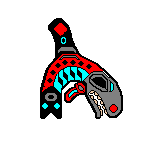A festival of orcas
In June, 1994, researchers observed a gathering of all three pods of
the Southern Resident Community. They socialized in small groups of 5 to
15, spread out over 5-10 square miles of ocean surface. At any one time
as many as five or six such groups could be seen. The whales seemed to mix
and mingle without regard to pod association. Calves and juveniles joined
the adult males and females in rubbing together, slowly slapping the water
with every appendage, spyhopping, and pushing each other to the surface.
They moved in a slow motion, ballet-like pace.
Groups were not seen to come together at the surface; rather when a group
began to appear at the surface, the members were already tightly gathered
and engaged in tactile behaviors. When at the surface, there was usually
a rush of ten or more shallow blows per whale over the course of 2-3 minutes,
then the group would sink and in many cases not reappear as a group. Individuals,
or small groups such as mothers and calves were sometimes seen travelling
from group to group, always eventually merging together into newly formed
associations. They vocalized incessantly in unusual whistles, squeaks and
honks.
This tactile play was observed on several occasions in mid-June, and has
been observed in spring and fall in previous years.
|


